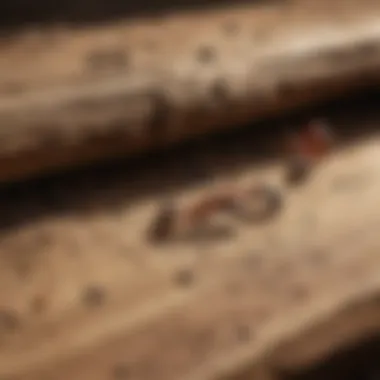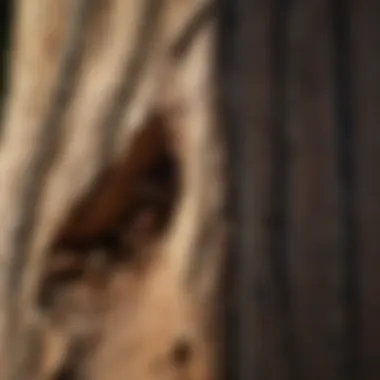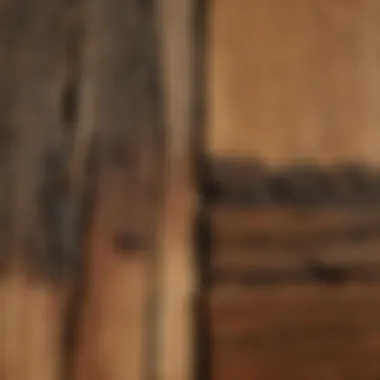Understanding the Impact of Ant Damage on Wooden Structures: A Comprehensive Analysis


Preventive Pest Control Strategies
When it comes to safeguarding your home against the detrimental effects of ant damage on wood structures, implementing preventive pest control strategies is paramount. In this section, we will delve into various aspects of pest control to help you maintain a pest-free environment both indoors and outdoors.
House Exterior Protection
One of the key elements of preventing ant damage on wood structures is to focus on protecting the exterior of your house. This includes tips for sealing cracks effectively to prevent ants from finding entry points. Clearing debris around the exterior of your house can also eliminate potential nesting sites for pests. Furthermore, implementing measures to prevent pests from entering your home, such as installing screens on windows and doors, can be highly effective in keeping ants at bay.
Yard Maintenance
A well-maintained yard plays a crucial role in pest control. Essential yard care routines such as regular mowing, trimming bushes, and removing standing water can help in deterring pests, including ants. Implementing methods like keeping vegetation trimmed away from the house and removing woodpiles can reduce the likelihood of ant infestations in your yard.
Indoor Cleanliness
Maintaining a clean indoor environment is essential for preventing ant damage on wood structures. Expert cleaning tips and techniques, such as vacuuming regularly, wiping down surfaces, and proper food storage, can help eliminate the attractive elements that draw ants indoors. Additionally, sealing cracks and crevices indoors can further deter ant invasions.
Garbage Disposal
Proper garbage disposal is a critical aspect of pest prevention. Implementing efficient waste disposal methods, such as securely bagging trash and ensuring bins are tightly closed, can help in reducing ant attractants. The importance of proper garbage disposal in preventing pest infestations cannot be overstated.
Other Pest Prevention Strategies
In addition to the aforementioned strategies, there are innovative ways to safeguard your home against ant damage. This can include utilizing natural repellents, like citrus peels or vinegar, to deter ants. Additionally, investing in pest-resistant building materials and regularly inspecting your property for signs of pest activity can proactively address potential infestations.
Introduction
Overview of Ant Damage
Types of Ant Species
Exploring the intricate world of Types of Ant Species reveals a nuanced spectrum of creatures capable of wreaking havoc on wood structures. Each species brings its unique set of characteristics and behaviors to the table, influencing the extent and nature of the damage inflicted. By deciphering the key features of various ant species in relation to wood degradation, individuals can gain valuable insights into the specific threats posed and tailor their preventive strategies accordingly. Understanding the nuances of different ant types is instrumental in devising targeted pest management plans tailored to mitigate the risks effectively.
Impact on Wood Structures
The Impact on Wood Structures paints a vivid picture of the consequences of ant infestations on the physical properties of wood. From undermining the structural stability to compromising the aesthetic appeal, ant damage can have far-reaching implications on the longevity and functionality of wooden assets. By recognizing the pivotal role ants play in deteriorating wood structures, individuals can acquaint themselves with the urgency of addressing infestations promptly. Exploring the nuances of ant-induced wood damage provides valuable insights into the specific vulnerabilities that necessitate immediate attention, guiding property owners towards proactive preservation practices.
Signs of Ant Infestation


Visible Damage
Diving into the realm of Visible Damage offers a visual narrative of the insidious effects of ant activity on wood surfaces. From tell-tale trails of destruction to discernible alterations in texture and appearance, signs of visible damage serve as glaring indicators of underlying infestations. By honing in on these visual cues, individuals can swiftly identify the presence of ants and implement remedial measures to prevent further deterioration. Understanding the visual manifestations of ant infestations enhances one's ability to detect issues early on, mitigating potential risks and preserving the structural integrity of wood.
Auditory Clues
Engaging with the realm of Auditory Clues unlocks a realm of sensory signals that hint at the presence of ants within wooden structures. From faint rustling sounds to subtle tapping noises, auditory clues offer subtle yet crucial hints at the covert activities of these persistent pests. By attuning oneself to these auditory cues, individuals can proactively address ant infestations before they escalate, minimizing the extent of damage and preserving the tranquility of the living environment. Exploring the auditory dimensions of ant infestations enriches one's ability to detect subtle signs of wood damage, enabling swift intervention and effective pest management strategies.
Mechanisms of Ant Damage
Ants can cause significant damage to wood structures through various mechanisms, making it imperative to understand how these tiny creatures impact our wooden assets. By delving into the mechanisms of ant damage, individuals can gain insights into the specific ways different ant species affect wood, leading to potential structural weaknesses and safety concerns.
Wood-Boring Ants
Wood-boring ants are a notable threat to wooden structures due to their tunneling activities and feeding habits. Their ability to bore into wood creates pathways that weaken the integrity of the material, potentially compromising the structural stability of the affected areas. By comprehensively examining the behaviors of wood-boring ants, individuals can better comprehend the extent of damage these pests can cause.
Tunneling Activities
Tunneling activities represent a crucial aspect of wood-boring ants' behavior, as they relentlessly dig through wooden materials to create nests and galleries. This continuous tunneling weakens the wood, making it more susceptible to structural damage and decay. The intricate network of tunnels formed by these ants can extend deep into the wood, further exacerbating the structural integrity issues.
Wood-boring ants' tunneling activities serve as a key contributor to the overall degradation of wood structures, highlighting the persistent and destructive nature of these pests. The extensive tunneling can compromise the load-bearing capacity of wood, posing safety hazards and necessitating timely intervention to prevent further deterioration.
Feeding Habits
In addition to tunneling activities, wood-boring ants' feeding habits play a vital role in causing damage to wood structures. As they feed on wood components such as cellulose and lignin, these ants not only consume essential parts of the wood but also introduce moisture and fungal growth, accelerating the deterioration process.
Wood-boring ants' feeding habits contribute to the overall breakdown of wood integrity, as the combined effects of tunneling and feeding lead to structural weaknesses and potential collapses. Understanding these feeding behaviors is essential for implementing targeted pest control measures to mitigate the impact on wooden assets.
Nesting Behaviors
Ants' nesting behaviors, including moisture accumulation and structural compromise, further exacerbate the detrimental effects of ant damage on wood structures. These behaviors can significantly amplify the structural weaknesses introduced by tunneling activities and feeding habits, emphasizing the need for proactive measures to address ant infestations promptly.
Moisture Accumulation
Moisture accumulation within ant nests can create favorable conditions for fungal growth and wood decay, accelerating the deterioration of wooden structures. Wood-boring ants' nesting activities often involve retaining moisture within galleries and tunnels, contributing to long-term structural damage and compromising the wood's integrity.
The unique feature of moisture accumulation by wood-boring ants lies in its ability to facilitate not only structural degradation but also the proliferation of other wood-damaging organisms. Addressing moisture accumulation is crucial for preventing extensive damage and preserving the longevity of wood structures.
Structural Compromise


Structural compromise resulting from ants' nesting behaviors poses a serious threat to wood structures, as the insects weaken the material's integrity and stability. Ant colonies may inhabit structurally critical areas, leading to compromised load-bearing capacity and potential collapses if left unattended.
The key characteristic of structural compromise caused by ants lies in its insidious nature, gradually undermining the wood's strength without immediate visible signs. This gradual deterioration can go unnoticed until significant damage has already occurred, underscoring the importance of regular inspections and proactive maintenance to safeguard wooden assets.
Preventive Measures
Preventive measures play a crucial role in safeguarding wood structures against the destructive impact of ant damage. By implementing strategic preventive actions, homeowners can mitigate the risks associated with ant infestations and preserve the integrity of their wooden assets for the long term. These measures not only serve to protect the structural soundness of buildings but also contribute to maintaining property value and aesthetics.
Sealing Entry Points
Effective sealing of entry points is paramount in preventing ant incursions into wood structures. By focusing on sealing openings and gaps through caulking cracks and repairing gaps, individuals can create a formidable barrier against ant intrusion. Properly sealed entry points help minimize the likelihood of ant infestations and limit the access points for these pests, thereby reducing the potential for structural damage.
Caulking Cracks
Caulking cracks involves filling in small openings and crevices in wooden structures to prevent ants from entering. This meticulous process helps eliminate vulnerable entry points that ants may exploit, ensuring a more secure environment for wood preservation. The resilience and versatility of caulking make it an ideal choice for sealing off potential ant pathways, offering a durable solution to fortify wooden structures against invasive pests.
Repairing Gaps
Repairing gaps in wood structures is essential for maintaining their structural integrity and preventing ant infiltration. Addressing gaps through appropriate repair techniques not only enhances the aesthetic appeal of the wood but also reinforces its durability against external threats. By resolving gaps promptly, homeowners can effectively deter ants from accessing vulnerable areas and protect their wooden assets from potential harm.
Moisture Control
Controlling moisture levels is another key aspect of preventing ant damage to wood structures. By implementing ventilation systems and utilizing dehumidifiers, individuals can regulate indoor humidity levels and create an unfavorable environment for ants to thrive. Proper moisture control not only prevents wood decay and fungal growth but also diminishes the attractiveness of wooden materials to foraging ants, reducing the likelihood of infestation.
Ventilation Systems
Ventilation systems play a vital role in moisture regulation within enclosed spaces, promoting air circulation and preventing dampness buildup. By incorporating efficient ventilation mechanisms, homeowners can optimize indoor air quality and reduce the excess moisture that attracts ants to wooden structures. Well-ventilated spaces discourage ant activity and contribute to the overall preservation of wood surfaces.
Dehumidifiers
Dehumidifiers offer a practical solution for reducing humidity levels and controlling moisture in indoor environments. These devices extract excess moisture from the air, creating a drier atmosphere that discourages ant infestations and protects wooden surfaces from moisture-related damage. Incorporating dehumidifiers as part of a comprehensive moisture control strategy enhances the longevity of wood structures and minimizes the risk of ant-induced deterioration.
Professional Inspection
Periodic professional inspections by certified pest control experts are essential for detecting early signs of ant activity and addressing potential infestation threats in a timely manner. Certified pest control services combine expertise with specialized tools to conduct thorough assessments and implement targeted treatment measures, safeguarding wood structures from extensive damage.
Certified Pest Control
Engaging certified pest control professionals ensures that ant infestations are managed effectively and in compliance with industry standards. Certified specialists possess the knowledge and resources to identify ant species, assess infestation severity, and apply appropriate control measures to eradicate pests. By relying on certified pest control services, homeowners can entrust their wood structures to experienced professionals dedicated to preserving the integrity of their properties.


Timely Assessments
Timely assessments conducted by pest control experts enable early detection of ant infestations and proactive intervention to prevent escalation. By scheduling regular inspections and timely assessments, individuals can stay ahead of potential ant threats and address underlying issues before they escalate. Prompt identification of ant activity allows for targeted interventions, mitigating the impact of infestations and protecting wood structures from extensive damage.
Repairing Ant Damage
As we delve into the intricate world of combating ant damage on wood structures, the repair process emerges as a vital aspect deserving detailed attention. Repairing ant damage not only ensures the structural integrity of wooden assets but also contributes significantly to safeguarding against future infestations. By addressing ant-induced damage promptly, individuals can mitigate risks associated with weakened wood structures and prevent extensive harm.
Assessment of Structural Integrity
Extent of Damage
Exploring the extent of damage caused by ant infestations unveils critical insights into the overall condition of wood structures. Understanding the specific aspects of damage, such as tunnels created by wood-boring ants or feeding habits that compromise wood integrity, is crucial for determining the appropriate repair solutions. The extent of damage serves as a key indicator of the urgency and extent of restoration needed, guiding individuals towards tailored repair interventions.
Safety Concerns
Safety concerns arise as a paramount consideration when addressing ant-related damage on wood structures. The potential risks associated with compromised structural integrity highlight the importance of prioritizing safety during repair processes. By identifying and mitigating safety hazards posed by ant damage, individuals can ensure a secure environment and prevent accidents or further structural deterioration.
Treatment Options
Wood Replacements
Embarking on wood replacements forms a fundamental part of the repair journey post-ant damage. The meticulous process of removing and replacing damaged wood sections not only restores the structural integrity but also eliminates potential nesting sites for future ant colonies. The durability and aesthetic appeal of wood replacements make them a popular choice for enhancing the longevity and visual appeal of repaired wood structures.
Chemical Treatments
Integrating chemical treatments into the repair regimen offers a proactive approach to eradicating existing ant colonies and deterring future infestations. The targeted application of ant-repelling chemicals safeguards wood structures against potential damage, serving as a preventive measure to maintain structural robustness. However, careful consideration of the environmental impact and human safety aspects is crucial when opting for chemical treatments as part of the repair process.
Conclusion
Vigilance serves as the cornerstone for ensuring the longevity and durability of wooden structures. By remaining vigilant and actively monitoring for signs of ant infestations, property owners can detect issues at an early stage, thus minimizing the extent of damages. This proactive approach not only preserves the structural integrity of wood but also prevents the escalation of ant-related problems that could compromise the safety of inhabitants.
Importance of Vigilance
Long-Term Preservation
Long-term preservation plays a fundamental role in ensuring the sustainability of wooden structures. By implementing measures geared towards preserving wood from ant damage, property owners can extend the lifespan of their assets significantly. The key characteristic of long-term preservation lies in its ability to provide continuous protection against the detrimental effects of various ant species. This proactive approach helps mitigate risks associated with ant-induced damages, ultimately contributing to the overall stability and durability of wooden materials. Despite some inherent challenges, such as regular maintenance requirements, long-term preservation stands out as a beneficial choice for safeguarding wooden assets in this context.
Property owners can take advantage of the unique features offered by long-term preservation methods, such as environmentally friendly treatments and sustainable protection against ant infestations. These methods not only offer a high level of efficacy in deterring ant damage but also present advantages in terms of cost-effectiveness and reduced environmental impact. By prioritizing long-term preservation strategies, property owners can ensure the continuous protection of their wooden structures, mitigating potential risks and preserving the integrity of their investments.
Property Value
The aspect of property value intricately ties into the overall significance of safeguarding wooden structures from ant damage. Preserving wood from the harmful effects of ant infestations not only contributes to maintaining the aesthetic appeal of properties but also enhances their overall value. The key characteristic of property value enhancement lies in the intrinsic connection between well-maintained, ant-free wooden structures and elevated property values. Property owners who prioritize the protection of their wooden assets against ant damage can significantly increase the market worth of their properties.
Property value enhancement through effective ant damage prevention measures provides property owners with a competitive edge in the real estate market. By showcasing well-protected wooden structures that are free from ant-related issues, property owners can attract potential buyers and secure higher selling prices. The unique feature of property value enhancement demonstrates its ability to not only protect investments but also yield substantial returns in terms of elevated property valuations. Despite potential challenges such as initial investment costs, property value enhancement remains a favorable choice for property owners seeking to secure long-term profitability and market competitiveness.



